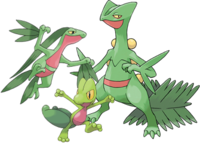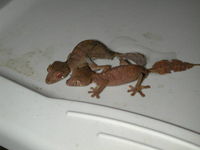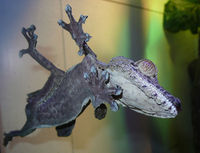On the Origin of Species: Treecko, Grovyle and Sceptile
|
In the animal kingdom, there's a lot to be said for keeping a low profile. There's usually something nearby that wants to eat you... or, alternatively, wants to avoid being eaten by you. Either way, it's in your best interests to avoid being noticed. Today, we'll meet a group of creatures that take stealth to a new level, able to blend seamlessly into their natural environment and climb almost any surface with the greatest of ease and stealth.
Treecko, Grovyle and Sceptile are primarily based upon the leaf-tailed gecko, a group of species that make up the genus Uroplatus. All of them are exclusively native to Madagascar and its surrounding islands, one of the world's greatest hotspots for biodiversity: most of the plant and animal species that live there are found nowhere else on Earth.
The leaf-tailed gecko is characterized by a large, flat tail that may resemble a leaf (their genus name, Uroplatus, is actually a Latinization of the Greek ουρά πλατύς, meaning 'flat tail'). The smallest of the species grows to just 4 inches in length, while the largest is around 12 inches. Smaller species are colored in order to blend in with leaves, while the larger ones usually resemble tree bark.
This coloration is part of a camouflage strategy, as is the flattened tail, and a similar adaptation is mentioned in some of Treecko's Pokédex entries. In real life, the tail is only truly leaf-like in a handful of the smaller species: U. phantasticus, U. malama and U. ebenaui. These seem to have been the primary inspiration for the Treecko family. U. phantasticus, also known (rather brilliantly, in my own twisted opinion) as the satanic leaf-tailed gecko, seems particularly Treecko-like. Its leaf-shaped tail even has notches in it, making it look like a dead leaf that's been nibbled by insects. They come in a variety of colors resembling foliage, though perhaps surprisingly, green seems to be uncommon, both in U. phantasticus and in the Uroplatus genus as a whole.
Leaf-like Uroplatus hide in the undergrowth amongst dead leaves, while larger species, patterned like tree bark, cling to trees where they usually blend in seamlessly. This is made easier in many species by a flap of skin that extends from the sides of the body and is pressed flat against the tree's surface: this has the effect of reducing any shadows the gecko may otherwise have cast. In some other groups of geckos, however, this skin flap has an additional use. As I said earlier, the Treecko family is primarily based on leaf-tailed geckos, but there's another group of geckos with which the Pokémon share some notable features.
Ptychozoon is a sister genus to Uroplatus, and the geckos in this group are known as flying geckos, or parachute geckos. 'Flying' may be a bit of an exaggeration, but they can certainly glide: upon jumping into the air, the flaps of skin along the sides of the body allow them to glide through the air, and control the speed of their descent. Both Grovyle and Sceptile's Pokédex entries make note of its agility and ability to leap from branch to branch; Grovyle's even describes this as 'flying'. In addition, Sceptile's tail bears quite a resemblance to that of Ptychozoon kuhli, also known as Kuhl's flying gecko.
On the subject of tails, geckos can use theirs as an emergency mechanism to escape from predators. Like many other creatures, they have the ability to abandon their tails if something catches them. Some of the tail's vertebrae have built-in weaknesses, and can be snapped by contracting certain muscles. The tail, left behind, continues to wriggle, tricking the predator into thinking that it still has live prey in its grasp. Meanwhile, the gecko can scurry to safety, and the lost tail will grow back in time (although with cartilage instead of bone).
We haven't even touched on the most famous and fascinating aspect of geckos, though: something hinted at in Treecko's Pokédex entries. Yes, geckos are renowned for their ability to climb almost any surface, no matter how smooth, without any sort of adhesive to help them. Whatever it is that holds them to the surfaces is extremely strong, because geckos have been seen to hang from smooth surfaces by just one toe. Another remarkable thing is that geckos can 'un-stick' from a surface as easily as they stick, which is obviously important for walking.
For years, scientists wondered how this could be possible, since there was nothing obvious about the gecko's toes that would make them 'sticky'. Even today, we're just beginning to understand the process, but it seems to be due to microscopic hair-like structures called setae on the toes of the gecko. Each one of these is much thinner than a human hair... and they are themselves covered with even smaller structures, called spatulae. These are really, truly tiny: 0.2 μm long, which is below the wavelength of visible light! It's these tiny spatulae that seem to be responsible for clinging to surfaces, using forces that operate at the atomic level. Individually, these forces are very weak, but the sheer number of attachment points makes for a very sticky surface indeed. And, when the gecko wants to un-stick its toe from a surface, it just has to bend it. Since their toes are jointed in the opposite direction from ours, it's just like peeling off a sticker: the forces are overcome by lifting up the tip of the toe first, and then gradually removing the rest of it.
Research has been underway for a while now to produce a synthetic replica of the gecko's toe, because such a thing has the potential to be a very useful adhesive (in sterile environments, for example, because it leaves no residue). Indeed, by mimicking the structure of a gecko's toe, scientists have produced a number of experimental adhesives that work in the same way, but none are as strong as the gecko's variant, mostly because technology doesn't yet allow us to engineer substances so precisely on such a tiny level. We've some way to go before we truly understand the mysteries of the gecko, but in the meantime, I think the Treecko family serves as a fitting tribute to a remarkable and mysterious group of creatures.



